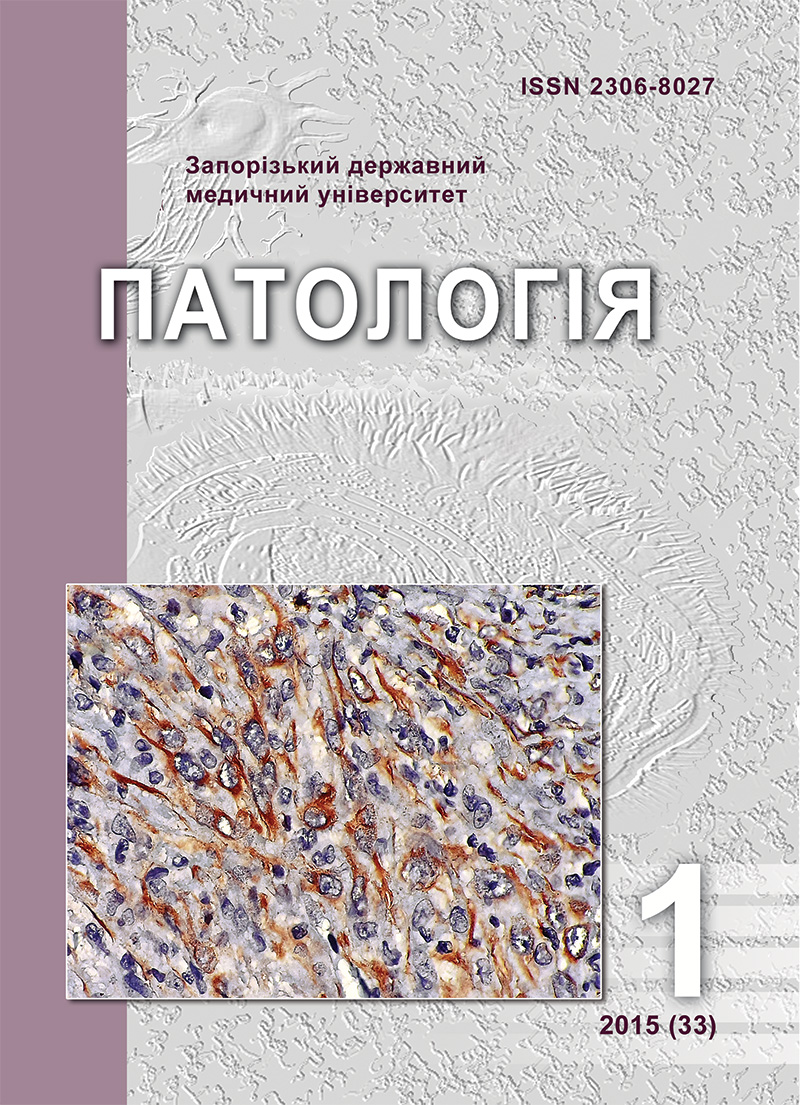The diagnostic and prognostic value of vascularization in papillary thyroid microcarcinomas
DOI:
https://doi.org/10.14739/2310-1237.2015.1.42931Keywords:
Papillary, Carcinoma, Thyroid Neoplasms, ImmunohistochemistryAbstract
Aim. Variety of clinical behavior of the thyroid microcarcinomas (PTM) is the reason for searching for the morphologic features of aggressive disease course.
Methods and results. In 22 cases of PTM immunohistochemical examination of CD34 and VEGF expression was performed to investigate the diagnostic and prognostic value of vascularization. The association between high level expression of VEGF, microvessels density and morphological features such as tumor invasion, desmoplastic stromal reaction, disorder of connective tissue maturation was revealed. The relationship between high levels of vascularization and TNM stage of disease, lymph node metastasis, extrathyroid invasion was not found.
Conclusion. Results indicate that the vascularization is a sign of growth and progression of microcarcinomas and it is not a significant predictor of the disease.
References
Khaziev, V. V. (2013). Osoblyvosti ekspresii kolaheniv u vuzlovykh novoutvorenniakh shchytopodibnoi zalozy [Feathers of the collagen expression in nodal neoplasm of the thyroid gland]. Problemy endokrynnoi patolohii, 2, 39–45. [in Ukrainian].
Akslen, L. A. & Livolsi, V. A. (2000). Increased angiogenesis in papillary thyroid carcinoma but lack of prognostic importance. Hum. Pathol., 31, 439–42. doi:10.1053/1-ip.2000.6548.
Cappelli, C., Castellano, M., & Braga M. (2007). Aggressiveness and outcome of papillary thyroid carcinoma (PTC) versus microcarcinoma (PMC): a mono-institutional experience. J. Surg. Oncol., 95, 555–60. doi: 10.1002/jso.20746.
Сheong, H. (2010). Microvessel and Lymphatic Vessel Density and VEGFR-3 Expression of Papillary Thyroid Carcinoma with Comparative Analysis of Clinicopathological Characteristics. The Korean Journal of Pathology, 44, 243–51. doi: 10.4132/KoreanJPathol.2010.44.3.243.
Cho, J., Kim, J., & Jeong, C. (2012). Clinical features and prognostic factors in papillary thyroid microcarcinoma depends on age. J Korean Surg Soc., 82(5), 281–287. doi: 10.4174/jkss.2012.82.5.281.
He, Y. (2004). Role of lymphangiogenic factors in tumor metastasis. Biochlm Biophys Acta, 1654(1), 3–12. doi: 10.1016/j.bbcan.2003.07.003.
Koperek, O., Asari, R., Niederle, B., & Kaserer, K. (2011). Desmoplastic stromal reaction in papillary thyroid microcarcinoma. Histopathology, 58(6), 919–24. doi: 10.1111/j.1365-2559.2011.03791.x.
Liang, Q. C., Wei, Q. Y., & Fan, S. Q. (2006). Expression of VEGF-C and angiogenesis, and lymphangiogenesis in papillary thyroid carcinoma. Zhong Nan Da Xue Xue Bao Yi Xue Ban., 31, 414–416.
Lloyd, R., De Lellis, R., Heitz, P., & Eng., C. (2004). World Health Organization Classification of Tumours: Pathology and Genetics of Tumours of the Endocrine Organs. Lyon: IARC Press International Agency for Research on Cancer.
Torre, N. G., Buley, I., Wass, J. A. & Turner, H. E. (2006) Angiogenesis and lymphangiogenesis in thyroid proliferative lesions: relationship to type and tumour behaviour. Endocr. Relat. Cancer, 13(3), 931–944. doi: 10.1677/erc.1.01210
Vong, S. & Kalluri, R. (2011). The Role of Stromal Myofibroblast and Extracellular Matrix in Tumor Angiogenesis. Genes Cancer, 2(12), 1138–1145. doi: 10.1177/1947601911423940.
Xing, M. (2007). BRAF mutation in papillary thyroid microcarcinoma: the promise of better risk management. Ann. Surg. Oncol, 28(7), 742–62. doi: 10.1245/s10434-008-0298-z.
Downloads
How to Cite
Issue
Section
License
Authors who publish with this journal agree to the following terms:- Authors retain copyright and grant the journal right of first publication with the work simultaneously licensed under a Creative Commons Attribution License that allows others to share the work with an acknowledgement of the work's authorship and initial publication in this journal.

- Authors are able to enter into separate, additional contractual arrangements for the non-exclusive distribution of the journal's published version of the work (e.g., post it to an institutional repository or publish it in a book), with an acknowledgement of its initial publication in this journal.
- Authors are permitted and encouraged to post their work online (e.g., in institutional repositories or on their website) prior to and during the submission process, as it can lead to productive exchanges, as well as earlier and greater citation of published work (SeeThe Effect of Open Access).

